NCERT Solutions of Class 9 Chapter 6 covers all topics that have a complete and detailed description. NCERT Solutions of Class 9 Chapter will help you understand all the topics given below.
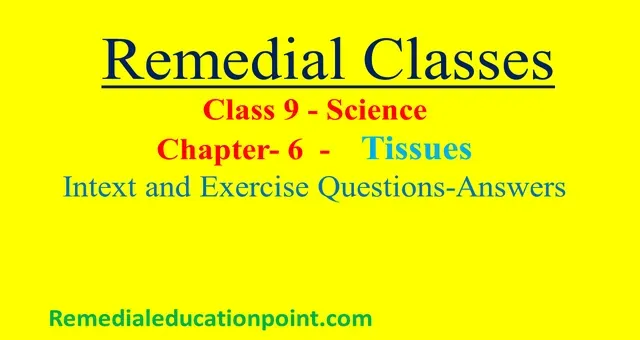 |
| NCERT Solutions of Class 9 Chapter 6 |
NCERT Solutions of
Class 9 Chapter 6 is based on CBSE syllabus
2021-22 that will help you to solve homework and home assignments in an easy
way.
|
Table of Contents |
NCERT Solutions of Class 9 Chapter 6
You are advised to
read toughly NCERT Solutions of Class 9 Chapter 6 and prepare notes and important points which will help
you to secure good marks and rank in exams.
Before we go ahead into
the NCERT Solutions of Class 9 Chapter 6, we should know an overview
of NCERT Solutions of Class 9 Chapter 6 Tissues
NCERT Solutions for Class 9 Science Chapter 6 Tissues Overview
1. Are Plants and Animals Made of Same Types of Tissues?
2. Division of labour
3. Plant Tissues
a. Meristematic tissue
b. Permanent tissue
4. Animal Tissues
a. Epithelial tissue
b. Muscular tissue
c. Connective tissue
d. Nervous tissue
These NCERT Solutions for Class 9 Science Chapter 6 are for Students of CBSE affiliated schools and, RBSE and all other states can download Solutions of Chapter 6 Tissues of NCERT Science for Class 9 in English medium and Hindi medium in PDF format for free.
NCERT Class 9 Science Chapter 6 Tissues Questions- Answers
Intext Questions
Class 9 ch 6 questions answer Page No. 69
Q.1 What is a tissue?
Ans. Tissue is a group of related cells that have a common origin and perform a common function.
Q.2 What is the utility of tissues in multi-cellular organisms?
Ans. In multi-cellular organisms, the different types of tissues perform different functions. Since a particular group of cells called tissue performs a particular function, they do it very efficiently. Thus, multi-cellular organisms possess a definite division of labour. tissues provide structural strength, mechanical strength, and division of labour.
Class 9 ch 6 questions answer Page No. 74
Q.3 Name types of a simple tissue.
Ans. These are three types of simple tissue –
1. Parenchyma
2. Collenchyma
3. Sclerenchyma
Q.4 Where is apical meristem found?
Ans. Apical meristem is found at the root and stem apex.
Q.5 Which tissue makes up the husk of coconut?
Ans. Sclerenchymatous fibres.
Q.6 What are the constituents of phloem?
Ans. The four constituents of phloem are –
(a) Sieve tube
(b) companion cells
(c) phloem parenchyma and
(d) phloem fibres
Class 9 ch 6 questions answer Page No. 78
Q.7 Name the tissue responsible for the movement in our body?
Ans. Muscular tissues and nervous tissues. The combination of both tissues is responsible for the movement in our body.
Q.8 What does a neuron look like?
Ans. Neuron looks like a miniature tree with thin hair-like parts arising from its ends. Neuron has a cell body with a nucleus and cytoplasm. Each neuron has a single long part called an axon. A neuron has many short hair-like structures called dendrites.
Q.9 Give three features of cardiac muscles.
Ans. (i)The cells of cardiac muscles are cylindrical, branched, and uninucleate.
(ii) These are involuntary and can’t be controlled by us.
(iii)These muscles show rhythmic contraction and relaxation throughout life.
Q.10 What are the functions of areolar tissue?
Ans. Areolar tissue supports internal organs and helps in the repair of the tissues. they are connective tissues found in animals and present between skin and muscles, around blood vessels and nerve,s and in the bone marrow. These tissues fill the space inside the organs.
Also, read
NCERT Solutions for Class 9 Science Chapter 6 Exercise
Q.1 Define the term “tissue”.
Ans. Tissue is a group of related cells that have a common origin and perform a common function.
Q.2How many types of elements together make up the xylem tissue? Name them.
Ans.(i) Tracheids
(2) Vessels
(3) Xylem parenchyma and
(4) Xylem fibres.
Q.3How are simple tissues different from complex tissues in plants?
Ans. Differences between simple and complex tissue.
|
Simple
tissue |
Complex tissue |
|
1. It
is formed of only one type of cells. 2. All
the cells perform the same function. 3. They
form primary structure of the plant. |
1. It
is formed of more than one type of cells. 2. The
different cells perform different fraction of a function. 3. They
form transport system the plant. |
Q.4Differentiate between parenchyma, collenchyma, and sclerenchyma on the basis of the cell wall.
Ans.Differences between parenchyma, collenchyma, and sclerenchyma.
|
Parenchyma
|
Collenchyma |
Sclerenchyma |
|
1.The
cell wall is thin 2.The
cell wall is smooth 3.The
cell wall is formed of cellulose |
The
cell wall is thickened at corners The
cell wall is unevenly thickened The
cell wall is pecto cellulosic |
The
cell wall is thickened The
cell wall is uniformly thickened. The
cell wall is cellulosic but thickening is lignified |
Q.5 What are the functions of stomata?
Ans. Functions of stomata:
(i) They are sites where the exchange of gases occurs between the plant interior and external environment.
(ii) Major part of transpiration occurs through stomata.
(iii) They regulate both gaseous exchange and transpiration.
Q.6 Diagrammatically show the difference between the three types of muscle fibres.
Ans. Muscle fibres are of three types- (i).Striated muscle (ii).- smooth muscle (iii). Cardia muscle
(i). striated muscle
a. The cells of these muscles are long, cylindrical with many nuclei and unbranched.
b. They are connected to bones.
c. They are voluntary muscles.
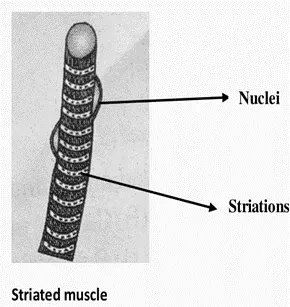 |
| striated muscle |
(ii). Smooth muscles-
a. They are involuntary muscles.
b. They are found in the alimentary canal and lungs.
c. They are spindle in shape and have a single nucleus.
 |
| Smooth muscles |
(iii). Cardiac muscles –
a. They are found in the heart.
b. They are involuntary muscles.
c. They are cylindrical, branched, and uni-nucleate.
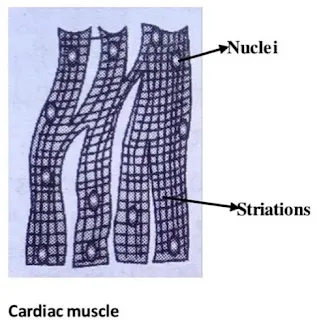 |
| Cardiac muscles |
Q.7 What is the specific function of the cardiac muscle?
Ans. Cardiac muscle contracts and relaxes rapidly and continuously with a rhythm. Their rhythmic contraction and relaxation help in the pumping of blood.
Q.8 Differentiate between striated, un-striated, and cardiac muscles on the basis of their structure and site/location in the body.
Ans.
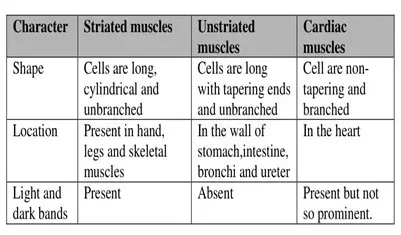 |
| Difference between striated , unstriated and cardiac muscles |
Q.9 Draw a labeled diagram of a neuron.
Ans.
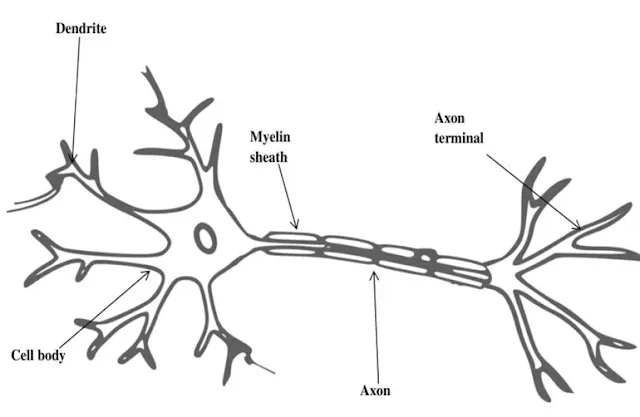 |
| labeled diagram of a neuron. |
Q.10 Name the following:
(a) Tissue that forms the inner lining of our mouth.
(b) Tissue that connects muscle to bone in humans.
(c) Tissue that transports food in plants.
(d) Tissue that stores fat in our body.
(e) Connective tissue with a fluid matrix.
(f) Tissue present in the brain.
Ans. (a) Stratified squamous epithelium.
(b) Tendon
(c) Phloem
(d) Adipose tissue
(e) blood
(f) Nervous tissue
Q.11 Identify the type of tissue in the following: skin bark of tree, bone, the lining of kidney tubule, vascular bundle.
Ans. Skin: Epithelial tissue.
Bark of tree: Cork (Protective tissue)
Bone: connective tissue
Lining of kidney tubule: Cuboidal epithelium tissue
Vascular bundle: Complex or conducting tissue (xylem and phloem)
Q.12 Name the region in which parenchyma tissue is present.
Ans. Parenchyma is found in almost all non-woody parts of the plant such as cortex, pith, medullary rays of stem, cortex, and pith of roots, leaf flowers, the pith of fruits, etc. it is a basic packing tissue.
Q.13 What is the role of the epidermis in plants?
Ans. The epidermis acts as protective tissue in plants and protects underlying tissues, Epidermis helps in absorption, secretion, excretion, transpiration, and gaseous exchange also. It protects the entry of pathogens.
Q.14 How does the cork act as a protective tissue?
Ans. Cork act as a protective layer because its cells are dead, filled with tannins, resin and air.
Q.15 Complete the table –
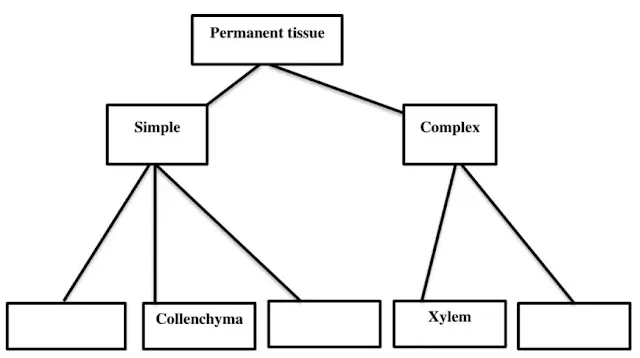 |
| Chart of Permanent tissues plants |
Ans.
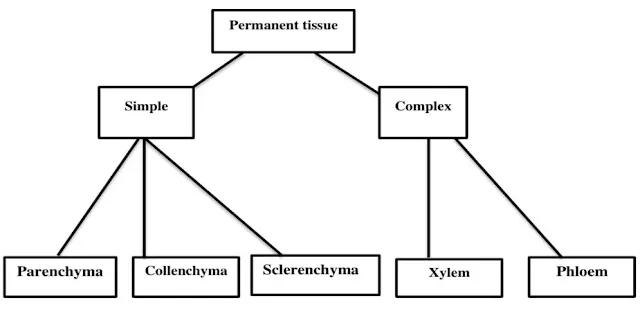 |
| Chart of Permanent tissues plants |
Also, read
Important points of Class 9 Science ch 6 Tissues
You have read the NCERT Solutions of Class 9 Chapter 6, below you have been given some important points of class 9 science ch 6 tissue that will help you understand the whole chapter 6 tissue.
1. Tissue is a group of cells similar in structure and functions.
2. Division of labour refers to the distribution of different functions among different parts of the body of organisms that get specialized for a particular function.
3. Plant tissue is of two types – Meristematic and Permanent tissue
4. Meristematic tissue is the dividing tissue present in the growing regions of the plant.
5. Meristematic tissues are divided into three types on the basis of their position – Apical, lateral and intercalary meristem.
6. Permanent tissue is derived from meristematic tissue. Once they lose the ability to divide. They are classified as simple and complex tissue.
7. Parenchyma, collenchyma, and sclerenchyma are three types of simple tissues.
8. Simple tissues are made up of only one type of cell which performs the same function.
9. Xylem and phloem are two types of complex tissues found in plants.
10. Complex tissues are made up of more than one type of cell and they work together to perform the same functions.
11. Xylem conducts water and minerals.
12. Phloem contains sieve cells, companion cells, phloem parenchyma, and phloem fibres.
13. Phloem transports food.
14. Xylem contains tracheids, vessels, xylem fibres, and xylem parenchyma.
15. Animal tissues can be epithelial, connective, muscular, and nervous tissues.
16. Depending on shape and function, epithelial tissue is classified as squamous, cuboidal, columnar, ciliated, and glandular.
17. The different types of connective tissue in our body include areolar tissue, adipose tissue, bone, tendon, ligament, cartilage, and blood.
18. Epithelial tissues cover the entire body as well as internally.
19. Striated, unstriated, and cardiac are three types of muscle tissue.
20. nervous tissue is made of nerves that receive and conduct impulses.
Important Facts of Class 9 Science ch 6 Tissues
You will certainly gain extra knowledge when you go through the following Important Facts of Class 9 Science ch 6 Tissues
1. A French anatomist and pathologist Francois Xavier gave the term ‘tissue’.
2. Lignin – It is a complex molecule composed of phenylpropanoid units associated with cellulose. It works as cement and hardens the cell walls. It also provides flexibility and tensile and compressional strength.
3. Vessels are present in all angiosperms.
4. Hump of the camel is rich in adipose tissue which provides water and energy for the long term.
5. The term histology was coined by Mayer.
6. Founder of histology was Marcello Malpighi and he is also called the father of histology.
7. Leaf has only primary tissues.
8 . Histology deals with the study of “Tissues’
9. Lignin makes the cell wall impermeable that’s why important substances are unable to pass through it.
10. Nageli coined the term meristem.
11. Lateral roots arise endogenously from the pericycle.
12. The cells of sclerenchyma are divided into two types- fibres and sclereids.
13. The insulating fat body present in whales is called blubber.
14. Lightest wood is Ochroma lagopus.
15. Haematology deals with the study of blood.
16. Largest muscle of the human body is the Gluteus maximus.
17. Cuticle and stomata area absent on root.
18. Vessels are absent in pteridophytes and gymnosperm but they are found in some species of Selaginella and Pteridium.
19. Study of cartilage is known as Chondology.
20. Extracellular fluid- The fluid found outside the cells in animals is known as extracellular fluids.
21. Blood is called the river of life.
22. Heaviest wood is Guaicum officinale.
23. About 1% of RBCs are haemolysed per day.
Also, read
Important Terms related to Class 9 Science ch 6 Tissues
1. Actin- A fibrous protein present in the I band of muscle.
2. Epiphysis- Spongy ends of long bones having red bone marrow from RBCs.
3. Adipocytes – These are the fat-storing cells.
4. Embolus- A moving thrombus in the blood vessels.
5. Anaemia - The condition of deficiency of blood cells in the body.
6. Diaphysis- A soft part of a long bone is called diaphysis.
7. Bone marrow – A tissue present in the marrow cavity of bones.
8. Erythrocytopenia – This is the decrease in the condition of RBCs.
9. Thrombosis- The process of formation of a clot of blood in vessels.
10. Neuroglia – These are the non-nervous packing cells of nervous tissues.
11. Mast cells – Matrix and histamine secreting cells of the connective tissue.
12. Erythropoiesis – The process of formation of RBCs is called erythropoiesis.
13. Kuffer cells- The phagocytes present in the lives of mammals.
14. Fasciculi – These are bundles of muscle fibres or nerve fibres.
15. Goblet cells- These are mucilage-forming cells.
Oral questions of Class 9 Science ch 6 Tissues
Here few oral questions of class 9 science ch 6 tissues are given so must read and learn them. These will be very helpful and useful for your assessments
Question -1-What do you call a group of cells that perform a similar and particular function?
Answer- Tissues
Question -2- Are the tissue the same for animals and plants?
Answer- No
Question -3-What is the main function of nervous tissues?
Answer- Nervous tissues are the tissue that receives and transmits stimuli from one place to another within the body.
Question -4-Where is apical meristem located?
Answer- These tissues are present in the growing parts of roots and stems.
Question -5-Is Bone a tissue?
Answer- Yes
Question -6-Which animal tissue is called packaging tissues?
Answer- Areolar connective tissue
Question -7-What is plasma?
Answer- It is a fluid component of blood.
Question -9-Which tissue protects the entire body?
Answer- Epithelial tissues
Question -10-what are stomata?
Answer- These are minutes porous present in leaves.
Question -11-Name the components of the xylem.
Answer- Tracheids. Vessels, xylem parenchyma, and xylem fibres
Question -12- Give one function of RBCs.
Answer- Transportation of oxygen
Question -13-What are the main constituents of phloem?
Answer- Sieve tube, companion cell, phloem, phloem fibres.
Question -14-Name the tissue which transports water and minerals in plants.
Answer- Xylem
Question -15-Name muscle tissue of the human heart.
Answer- Cardiac muscles
Question -16- Name two basic tissues present in the plants.
Answer- Permanent tissues and meristematic tissue
Question -17-What is the common name of xylem and phloem.
Answer- Wood and Bast
Question -18- What are goblet cells?
Answer- Mucus secreting epithelial cells.
Question -19-Name the plant cell which is connected to the lateral side of the sieve tube.
Answer- Companion cell
Question -20- Name the neuron which carries impulses towards the brain.
Answer- Sensory neuron
Question -21- Name the tissue found in the hump of the camel.
Answer- Adipose tissue
Question -22-What is the main function of collenchyma
Answer- Provides mechanical strength
Question -23-Name the multinucleate muscle fibre
Answer- Skeletal muscle fibre
Suggested Topics of Class 9 Science ch 6 Tissues
For your upcoming exams, we are suggesting you some important topics. You should prepare notes and study them otherwise you can use the given study material absolutely free.
1. Meristematic tissue
2. Permanent tissue
3. Structure and functions of different types of permanent tissue
4. Complex permanent tissues – Xylem and Phloem
5. Functions and position of following animal tissues
a. Epithelial tissue
b. Connective tissues
c. Cartilage
d. Bone
e. Blood
f. Nervous tissue
g. Diagram of neuron
h. Different types of muscular tissues
i. Difference between epithelial tissues
j. Difference between permanent and meristematic tissue
These NCERT solutions and study material will help you good marks for your CBSE Board and other state board exams.
Remedial Education Point.com provides you complete study material for class 9 absolutely free. Now you can get accurate NCERT Book NCERT Solutions of Class 9 Chapter 6.
.jpg)



No comments:
Post a Comment